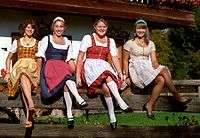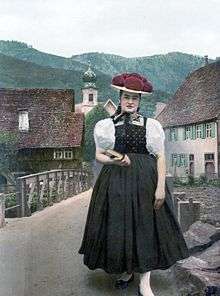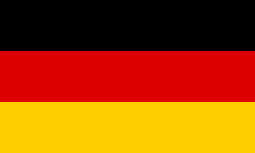Dirndl



A dirndl (German: [ˈdɪʁndl̩]) is the name of a traditional feminine dress worn in Austria, South Tyrol and Bavaria. It is based on the traditional clothing of Alps peasants.[1][2] Dresses that are loosely based on the dirndl are known as Landhausmode ("country-inspired fashion").
A dirndl skirt generally describes a light circular cut dress, gathered at the waist, that falls below the knee.[3][4]
Description
The dirndl consists of a bodice, puff sleeved blouse, full skirt and apron.[5][6][7] While appearing to be simple and plain, a properly made modern dirndl may be quite expensive as it is tailored and sometimes cut from costly hand-printed or silk fabrics.[2][6]
The winter style dirndl has heavy, warm skirts and aprons made of thick cotton, linen, velvet or wool, and long sleeves. The colors are usually rich and dark. The summer style is lighter and more revealing, has short sleeves, and is often made of lightweight cotton.
Accessories may include a long apron tied round the waist, a waistcoat or a wool shawl. In many regions, especially the Ausseerland, vibrantly colored, hand-printed silk scarfs and silk aprons are worn. As far as jewelry is concerned, women often sport necklaces, earrings and brooches made of silver, the antlers of deer or even animals' teeth. For colder weather there are heavy dirndl coats in the same cut as the dresses, with a high neck and front buttons, thick mittens and wool hats.
Different styles were worn in different regions,[2] but they are now more of a universally generalized and mass discharged cultural pastiche.[2]
History

Origins
The dirndl originated as a more hardy form of the costume worn today: the uniform of Austrian servants in the 19th century (Dirndlgewand means "maid's dress"). Simple forms were also worn commonly by working women in plain colors or a simple check. The Austrian upper classes adopted the dirndl as high fashion in the 1870s, making it a highly fashionable and popular must-have item in the nation soon after.[8]
Both skirts and pinafore dresses with vest-shaped tank tops, cooking aprons and blouses were commonplace in Europe in the 17th and 18th centuries.[8]
The basic blouse\skirt\corset idea came from the eastern regions of the Swiss Alps, and was originally a simple rural clothing. It later became female Austrian servants' work clothes as well as Alpine peasant attire in the 18th century and exclusively servant’s work clothes in the 19th century.[8]
Austrian Emperor Franz Joseph and his wife Elisabeth of Bavaria liked rustic clothing called a 'sissi', which equates to what the normal folk called a 'dirndl'.[8]
It appeared in its current state of decorative format and style in eastern Switzerland in the 1890s, and spread in the early 20th century[9] to the south of Germany, Austria, Liechtenstein,[8][9] South Tirol, Trentino and Valcanale Friuli.
Modern usage
During the period of National Socialism was Mittelstelle German costume of National Socialist Women of the "Reich Commissioner for costume work" established under Gertrud Pesendorfer.[10] In the context of Nazi ideology her designs represented "renewed costume".
The "Entkatholisiert" "English:Uncivilised" style became popular as the Dirndl was officially "de-cocratized" (ie: the closed collars removed so it could gain an erotic decollete collar and\or off-the-shoulders neckline), the skirt was slightly shortened and the women's arms were no longer to be covered beyond the elbow, and it was thus modernised and romanticised as well as eroticised.[8][10] Gertrud Pesendorfer's declared goal was to free the costume of "overburdening by church, industrialization and fashionable cries" and "foreign influences" and to let the "rogue sub-culture" back again.[11]
Dirndl and Landhausmode were abandoned for a while after World War II. While the wearing of the corresponding garments was scarcely popular in the 1970s, it has grown strongly since the 1990s.[8][12][11][11]
In the 21st century, fashion designers have adopted the dirndl, with varying results.[8][12][11][11] It ihas become a popular Upper Tirol and Bavarian fashion[13][14] and regular party outfit during Oktoberfest.
The 'dirndlkjoler'\'Dirndl kjoler kleid,' is more common here with short skirts, bodice just reaching to below the breasts, and dirndl-blouses with deep neckline and bare shoulders. There are also push-up bras that lift and collect the bust at the neckline.[13][14]
In Switzerland, the dirndl is the official outfit for certain representations, events, cultural shows and singing old folk songs (like yodeling).[9]
Today, dirndls vary from simple off-the-shelf styles to exquisitely crafted, very expensive models.[5][7] [8]
The scruffy, sexed-up, "de-cocratized" or economy versions and disjointed dresses that are loosely based on the dirndl are known as Landhausmode (lit:county house mode) dresses.[5][7] [15][16][17][18][19][20][21]
These have not been "de-cocratized" [22][17] and these are "de-cocratized" [23][24]
Naming
In the South German dialects (Bairisch), Dirndl originally referred to a young woman or a girl, while the word Dirndlgewand referred to the dress.[25] Nowadays, Dirndl may equally refer to either a young woman or to the dress.[25]Dirndl is a diminutive form of the dated word Dirn(e) for "girl"; in the 20th century, Dirne (originally an euphemism) has also developed towards meaning "prostitute".[25] The word is “Dirne” standardized German and “Deern” Low Saxon.[25]
- Dirndl-kleid, lit: "maid girl’s dress".
- Dirndlgewand, lit: "maid girl’s dressing-gown".
- Dirndlgwand, lit:" maid girl’s wreath dress".
- Landhausmode, lit: "country house mode”
- Dirndlkjoler kleid, lit: "maid girl’s dress".
- Dirndlkjoler, lit: "maid girl’s dressing-gown".
- Dirndlrock: "maid girl's dressing skirt."
Etiquette
The dirndl is mostly worn in Austria and Bavaria. It is used as an everyday dress primarily by older women in rural areas. Other women may wear it at formal occasions (much like a Scotsman wearing a kilt) and during certain traditional events. It is hugely popular also among young women at the time of a Volksfest, such as the Oktoberfest in Munich (and similar festivals), although many women will only wear dirndl-style dresses, called Landhausmode, which may deviate in numerous ways and are often much cheaper.
In Austria and Bavaria, the dirndl may often be seen on women working in tourism-related businesses, and sometimes waitresses in traditional-style restaurants or beer gardens. It is also seen in these regions on women in the Volksmusik business.
It is sometimes reported that the placement of the knot on the apron is an indicator of the woman's marital status. A knot tied on the woman's left side indicates that she is single, a knot tied on the right means that she is married, engaged or otherwise "taken", a knot tied in the front centre means that she is a virgin and a knot tied at the back indicates that the woman is widowed.[26][27][28] It is not clear where this symbolism comes from, but apparently it is not so traditional, but of a post-modernist affair. Mrs Sonja Still, a Munich-based journalist, says: "Today people look more closely at this than ever."[29]
The Dirndl vs. Tracht and traditional folk costumes

It is important to distinguish between dirndl and folk costumes, which is typical for that particular region, or even village, which originally had each their own style costume. Folk costume has certain features and various details, which can be distinguished according to the place of origin and social status of the wearer. Dirndl (especially now) the following characteristic distinguishing details lacks is heavily stylized, but clearly influenced by typical Bavarian costume. A distinction is also among the typical dirndl (piece of clothing with an apron, a substance with traditional patterns and embroideries ) and rural domestic clothing, crafted from gray or colored linen, sometimes with leather bodice and trim.[8]
See also
 Austria portal
Austria portal Germany portal
Germany portal- Lederhosen
- Tracht
References
Notes
- ↑ Ethnic Dress in the United States: A Cultural Encyclopedia, eds. Annette Lynch; Mitchell D. Strauss (Lanham, MD: Rowman & Littlefield, 2015), p. 100
- 1 2 3 4 http://www.austria.info/us/austria-dirndl-temptation/dirndl-basics-1681393.html
- ↑ Watt, Alice (26 April 2012). "Dirndl Skirts". Elle. London. Retrieved 7 October 2013.
- ↑ Dacre, Karen (8 May 2012). "Spin out with springtime's dirndl skirt". London Evening Standard. London. Retrieved 7 October 2013.
- 1 2 3 "Oktoberfest Dirndl dress: the bow".
- 1 2 "German Dirndl - an illustated guide".
- 1 2 3 "How to wear a dirndl - The Lady & the Rose".
- 1 2 3 4 5 6 7 8 9 10 m.b.H., STANDARD Verlagsgesellschaft. "Keine Angst vorm Dirndl".
- 1 2 3 https://garderobchik.com/category-glossary_5.html#35
- 1 2 "Projekt – Universität Innsbruck".
- 1 2 3 4 5 m.b.H., STANDARD Verlagsgesellschaft. "Von Dirndln, Trachten und Akademikerbällen".
- 1 2 "HauptNews Detail - Echo Online".
- 1 2 DW (English) (10 September 2010). "The Dirndl Folk Dress - euromaxx" – via YouTube.
- 1 2 focusonline (25 September 2012). "Perfektes Dirndl-Dekolleté: Die modischen Tricks für die Wiesn-Tracht" – via YouTube.
- ↑ "Sommerdirndl".
- ↑ http://www.bavaria-lederhosen.com/en/top-suchbegriffe/
- 1 2 "Buy Heidi Red Dirndl Online - Germany - Ernst Licht, USA".
- ↑ "Dirndl.com - Original Bavarian Oktoberfest Dirndl Dress and Lederhosen".
- ↑ "Children".
- ↑ https://www.bavarian-superstore.de/
- ↑ "Dirndl : Wiesnkoenig USA".
- ↑ https://www.ernstlicht.com/media/catalog/product/cache/1/image/9df78eab33525d08d6e5fb8d27136e95/h/e/heidi-dirndl_new_site.jpg
- ↑ http://4.bp.blogspot.com/-1O1QKrMxngw/U6cS5JKXB5I/AAAAAAAAAR0/WiaeneAYTt4/s1600/dirndl1.jpg
- ↑ "Fashion dirndl Dress".
- 1 2 3 4 Arten-Meyer, Angela (1 January 2011). "Munique e Arredores: Alemanha! Por que não?". Books on Demand – via Google Books.
- ↑ http://www.bavarian-specialities.net/oktoberfest/dirndl-knot.html
- ↑ Salisbury, Yvonne (2009). München: Wo, Wann, Was (Revised (2010) ed.). Insider's Guides. p. 8.
- ↑ Rath, J. Arthur III (2011). Being Menehune. Bloomington, IN: iUniverse. p. 149.
- ↑ Stanek, Julia (18 September 2013). "The Dirndl Code: Expert Tips for a Rollicking Oktoberfest". Der Spiegel. Hamburg. Retrieved 7 October 2013.
Further reading
- Gexi Tostmann: Das Dirndl (Alpenländische Tradition und Mode). Verlag Christian Brandstätter, Wien 1998
- Heide Hollmer, Kathrin Hollmer: Dirndl. Trends, Traditionen, Philosophie, Pop, Stil, Styling. Edition Ebersbach, Berlin 2011, ISBN 978-3-86915-043-7
- Daniela Müller: Alles Dirndl. Anton Pustet Verlag, Salzburg 2013, ISBN 978-3-7025-0693-3
- Elisabeth Wallnöfer: Geraubte Tradition. Wie die Nazis unsere Kultur verfälschten. Sankt Ulrich, Augsburg 2011, ISBN 3867441944
External links
 Media related to Dirndl at Wikimedia Commons
Media related to Dirndl at Wikimedia Commons